Be careful what you wish for… After blathering on about Trojan Mice for ages people have actually paid attention. Thank you Paul Taylor for the mentions in this post ‘The Complex Problem with Big Change Programmes’ and ‘People Aren’t Sick of Change, They are Sick of Change Programmes’.
There’s an important point in Paul’s posts. Trying to change things in a straightforward, highly predictable and controlled environment is very different to trying to change things in a complex, unpredictable and uncontrolled environment. It’s not just a case of using the same tools to do a different job. You wouldn’t expect a carpenter to fix your gas boiler with a hammer and chisel. Trojan Mice are not the same as Prince 2 Project Management (although they do need a proportional level of management).
Thanks also to Neil Prior from Practice Solutions who arranged for me to explain the concept of Trojan Mice to a live audience. This is where the 900 seconds comes in. It’s basically 15 standard minutes, sounding a bit more interesting and hopefully attention grabbing.
900 Seconds of Trojan Mice. Here are the visuals I’m going to use in my 900 seconds; five of them. So that’s roughly three minutes a drawing. I’m posting them here as a bit of a road test. Any comments or observations gratefully received.
Setting the scene and planting the key messages: hopefully this does what it says on the tin. I think I should emphasise that this is about an approach to complex situations. It’s not an attack on project management and Prince 2 , they are approaches designed for controlled environments. Trojan Mice are about probing and gathering data to make sense of complex problems.
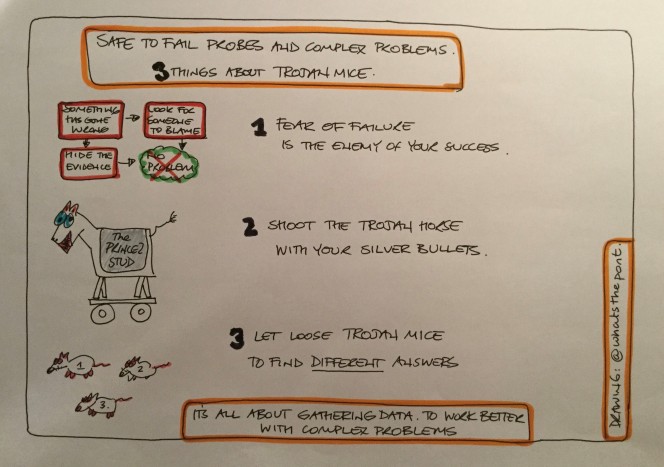
Fear of Failure is the Enemy of Success. I’m making the point here that attitudes to failure in organisations shape peoples’ behaviour. If there is a fear of failure, the learning that emerges from a failure or mistake is often lost (or buried). In addition, the fear of failure leads to a low risk culture where people don’t try anything that could fail and put them at risk. It’s all about seeking certainty and minimising the risks.
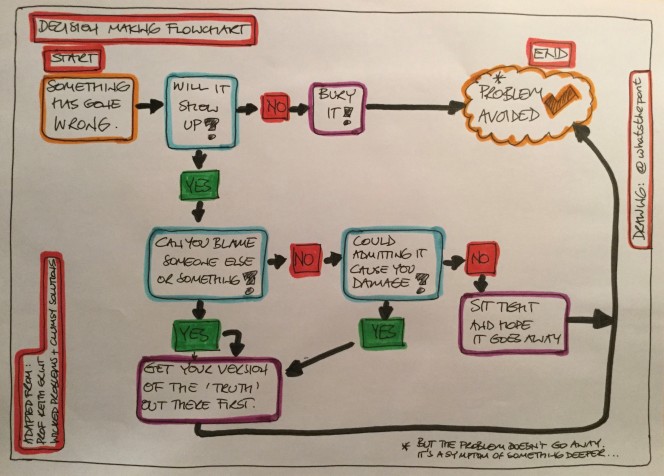
Shoot the Trojan Horse with your Silver Bullets. A few things going on here. Trojan Horses are the well managed projects that often get rolled out organisations. There’s often an illusion (delusion?) of certainty about them and an expectation that the ‘demonstrator pilot’ can easily be scaled up to be implemented across the whole; department, region, organisation, country. Frequently Trojan Horses are the ‘pet project’ of one individual. Something they are emotionally attached to. They might have skillfully used the ‘Project Management Options Appraisal’ section of the Business Case to make it appear as the ‘only game in town’. Sound familiar? (*cough, cough* I admit to doing this – in the past!).
Silver Bullets are just as mythical and unrealistic as Trojan Horses. They are the magical solutions that will solve all of our problems in a single shot. They are seductively attractive and lots of organisations are drawn to them as the easy fix, with depressing frequency. This re-occurrence happens so frequently that Matt Wyatt (@ComplexWales) has suggested they be called Silver Boomerangs, ‘because they keep coming back around’. All explained in this post The Life Cycle of a Silver Bullet.
The point of this drawing is to suggest you could solve two problems at once, by shooting the Trojan Horse with a Silver Bullet – nice!
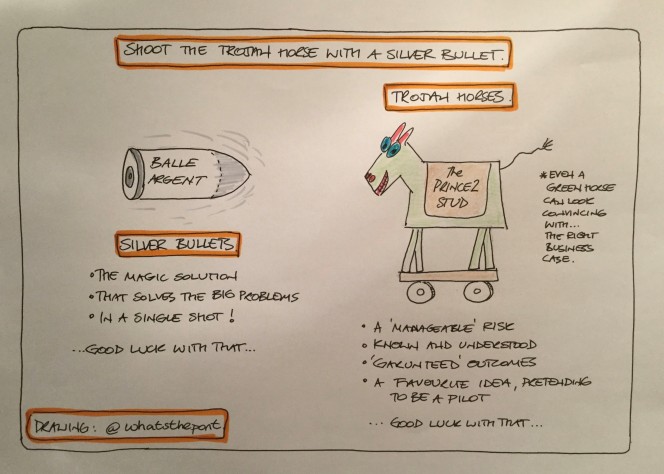
Trojan Mice. Safe to Fail Probes for Complex Problems. I’m hoping this is a fairly self explanatory drawing. The main point is that the more you probe and gather data about complex problems; the better position you are in to make sense of it and make good decisions about what to do next. The more Trojan Mice you deploy, the more data you will get.
The points about ‘Safe to Fail’ are obvious (I think). If you what to know more have a read of ‘Stop Talking, Start Experimenting’ by Paul Taylor on the work of Bromford Lab. There is a great graphic in this post that clearly shows the difference between Tests (Experiment / Trojan Mice) and Pilots.
One final bit I want to emphasise on the drawing is measurement. Deploying Trojan Mice is all about gathering data for measurement; in whatever form that measurement takes. Employ a Product Designer – they are pretty good at thinking from this perspective.
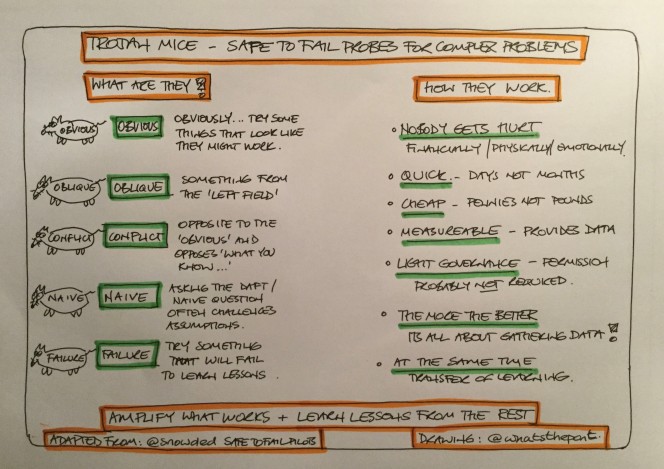
Trojan Mice and the Dolly Parton Challenge. Apologies if this feels completely left field (it’s all explained in this post). I’m just trying to make the point that the language that gets used around Trojan Mice matters. It’s ‘Horses for Courses’ and Mice for.. err…?
Anyway, it all boils down to taking well managed risks. If you are trying to get your proposals past the ‘Audit, Risk and Killers of Anything with a Spark or Creativity Committee’, you probably want to talk in terms of ‘Well Managed Risks’.
If you are turning up at a learning event full of the super cool innovators, thought leaders and like minded progressive thinkers, to blather on for 900 seconds, Trojan Mice are probably your thing.
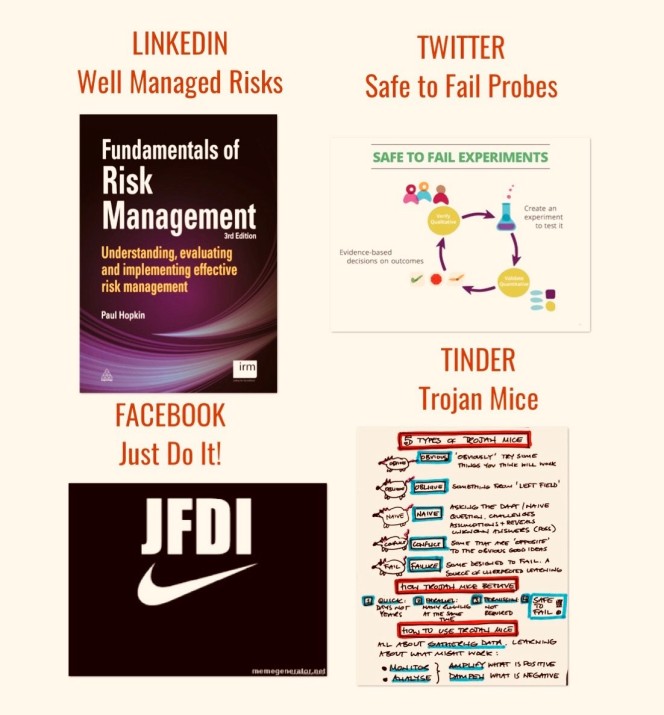
So, Whats the PONT?
- Trojan Mice are a tool for gathering data (probing) complex problems and situations. The more Trojan Mice you deploy, the more data you can gather to help you make sense of the problem/situation. That helps you make better decisions about ‘what next?’
- The tools you use depend on the circumstances. A tool that is designed for a ‘controlled’ environment is unlikely to work in a highly uncontrolled and unpredictable complex environment.
- How you talk about Trojan Mice depends on context. For an Audit and Risk Management Committee you are just describing a ‘Well Managed Risks’ approach. For others, Trojan Mice works just fine.
Resources: More info on Trojan Mice
The History of the term Trojan Mice explained by Harold Jarche (back in 2012) https://jarche.com/2012/10/on-trojan-mice/
General Description : https://whatsthepont.blog/2011/07/24/let-loose-the-trojan-mice-dont-waste-money-on-big-stuff/
Things that block Trojan Mice: https://whatsthepont.blog/2011/07/31/what%e2%80%99s-eating-the-trojan-mice/
Spotting the difference between Trojan Horses and Trojan Mice: https://whatsthepont.blog/2013/11/10/trojan-horses-are-not-trojan-mice-5-questions-to-spot-the-difference/

Leave a comment